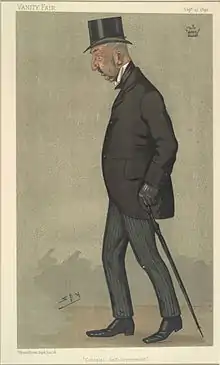The Lord Norton | |
|---|---|
 | |
| President of the Board of Health | |
| In office 8 March 1858 – 1 September 1858 | |
| Monarch | Victoria |
| Prime Minister | The Earl of Derby |
| Preceded by | Hon. William Cowper |
| Succeeded by | Office abolished |
| Under-Secretary of State for the Colonies | |
| In office 6 July 1866 – 1 December 1868 | |
| Monarch | Victoria |
| Prime Minister | The Earl of Derby Benjamin Disraeli |
| Preceded by | William Edward Forster |
| Succeeded by | William Monsell |
| President of the Board of Trade | |
| In office 21 February 1874 – 4 April 1878 | |
| Monarch | Victoria |
| Prime Minister | Benjamin Disraeli |
| Preceded by | Chichester Parkinson-Fortescue |
| Succeeded by | Viscount Sandon |
| Personal details | |
| Born | 2 August 1814 |
| Died | 28 March 1905 (aged 90) |
| Nationality | British |
| Political party | Conservative |
| Spouse(s) | Hon. Julia Leigh (1820–1887) |
| Alma mater | Christ Church, Oxford |

Charles Bowyer Adderley, 1st Baron Norton KCMG PC DL JP (2 August 1814 – 28 March 1905) was a British Conservative politician.
Background and education
Charles Bowyer Adderley was the eldest son of Charles Clement Adderley (d. 1818), offspring of an old Staffordshire family, and his wife, daughter of Sir Edmund Cradock-Hartopp, 1st Baronet.[1] Adderley inherited Hams Hall, Warwickshire, and the valuable estates of his great-uncle, Charles Bowyer Adderley, in 1826. He was educated at Christ Church, Oxford, where he graduated with a Bachelor of Arts in 1838.[1]
Political career
In 1841, Adderley entered the House of Commons as Member of Parliament for North Staffordshire, retaining his seat until 1878, when he was created Baron Norton.
Adderley's ministerial career began in 1858, when he was appointed President of the Board of Health and Vice-president of the Committee of the Council on Education in Lord Derby's short ministry.[1] Again under Lord Derby, he was Under-Secretary of State for the Colonies from 1866 to 1868, being in charge of the act which created the new Dominion of Canada, and from 1874 to 1878, he was President of the Board of Trade.[2]
He was sworn of the Privy Council in 1858,[3] was appointed a Knight Commander of the Order of St Michael and St George (KCMG) in the 1869 Birthday Honours,[4] and, in 1878, he was elevated to the peerage as Baron Norton, of Norton-on-the-Moors in the County of Stafford.[5]
Norton was a strong churchman and especially interested in education and the colonies.[2] He joined the Canterbury Association on 27 March 1848 and was a member of the management committee from the beginning. In 1852/53, he paid £500 towards the costs of the closure of the association.[6]
Family
In 1842 he married Julia Anne Eliza (1820–1887), oldest daughter of Chandos Leigh, 1st Baron Leigh, by whom he had several sons. His eldest son Charles Leigh Adderley succeeded him in the barony. Another son, the Hon. James Granville Adderley, vicar of Saltley, became well known as an advocate of Christian socialism.[2] His daughter Isabel married in 1876 Vauncey Harpur Crewe of Calke Abbey, later 10th Baronet.
Tributes
Adderley Street is a famous street in Cape Town, South Africa, considered the main street of the central business district. In 1850, the Mayor of Cape Town, Hercules Jarvis, named it to honour Adderley who had fought successfully against a proposal to make Cape Town into a penal colony.
In Birmingham, Adderley donated 8 acres (0.032 km2) of land to create Adderley Park,[7] which he managed privately from 1855 to 1864. He also donated land for the construction of St Saviour's Church, Saltley, St Peter's College, Saltley and the reformatory on the Fordrough, later called Norton Boys' Home. In 1879 Lord Norton sold Whitacre Lodge to the city for the construction of the 80 acres (0.32 km2) Shustoke Reservoir, the largest single source of water for Birmingham until the Elan/Claerwen scheme was completed.[7]
In Uppingham, Rutland, where he owned property, both Adderley Street and Norton Street are named after him.
Adderley Head, a headland between Lyttelton Harbour and Port Levy, near Canterbury, New Zealand, is named after him.[6]
Arms
  |
|
References
- 1 2 3 Dod, Robert P. (1860). The Peerage, Baronetage and Knightage of Great Britain and Ireland. London: Whitaker and Co. pp. 83–84.
- 1 2 3 One or more of the preceding sentences incorporates text from a publication now in the public domain: Chisholm, Hugh, ed. (1911). "Norton, Charles Bowyer Adderley, 1st Baron". Encyclopædia Britannica. Vol. 19 (11th ed.). Cambridge University Press. p. 797. This cites:
- W.S. Childe-Pemberton, The Life of Lord Norton (1909).
- ↑ The London Gazette, 26 February 1858
- ↑ "No. 23512". The London Gazette. 1 July 1869. p. 3750.
- ↑ The London Gazette, 16 April 1878
- 1 2 Blain, Rev. Michael (2007). The Canterbury Association (1848–1852): A Study of Its Members' Connections (PDF). Christchurch: Project Canterbury. pp. 9–10. Retrieved 2 April 2013.
- 1 2 "Adderley Estate". Birmingham City Council. Archived from the original on 27 September 2011.
- ↑ Burke's Peerage. 1949.